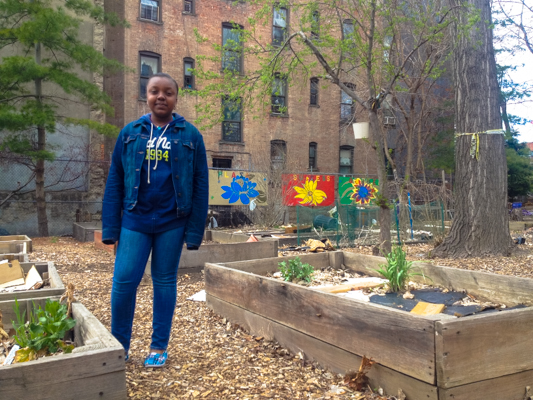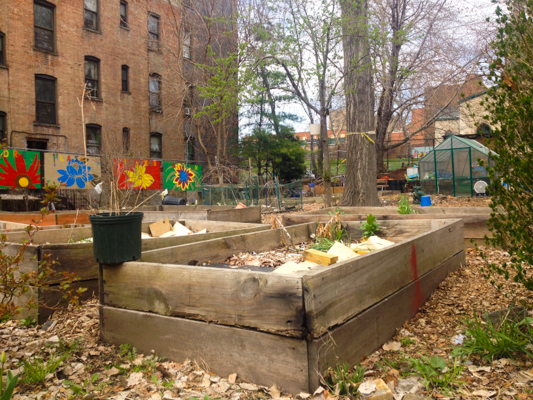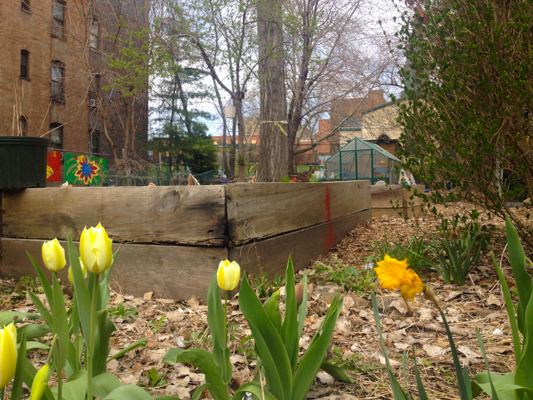The Bronx Builds the Next, Food-Savvy Generation
By Ellen Park
Shortly after a late spring frost in April, Jada Young, 13, checks in on some of the plants growing at the Padre Plaza Community Garden, a three-fourths of an acre garden plot in the South Bronx. Here and there are some casualties from the unusually harsh winter, like a morning glory that had bloomed last fall but didn’t survive the polar vortex. But some signs of spring are beginning to show. Several orange and yellow tulips have sprouted around the periphery, and a small mint plant is growing in one of the garden plots.
While many kids her age are looking forward to summer vacation, Jada is excited about the farmers market and growing season. Padre Plaza is the site of the Mott Haven Farmers Market held on 139th Street between Brooks and St. Ann Avenues. The farmers market is closed for the season until June, but Sheila Young, Jada’s mother and the market manager, says that neighbors have been asking since December when the farmers market will start up again. Farmers markets like the one in Mott Haven make fresh produce more accessible for neighborhoods in the Bronx.
Food security has increasingly been a topic on the national agenda, but for the Bronx it hits especially close to home. A 2012 report released by the Food Research and Action Center surveyed residents in each of the country’s 453 Congressional districts on whether they had enough money to purchase food for their families, or whether their situation fell into the category of “food hardship.” New York’s 16th District, where the South Bronx is located, was listed as the highest hardship area in the country at 36.3 percent. More recent data from New York City Harvest lists the Bronx at 23.2 percent. Though it seems things have improved, the Bronx still has the highest rate of food insecurity of the five boroughs (Manhattan is listed at 14.7 percent) and the number is nearly 7 points higher than the national average of 16.4 percent. Food insecurity is defined by the U.S. Department of Agriculture as not having “access by all people at all times to enough food for an active, healthy life.”
Sheila Young, who is 52, has lived in the South Bronx since she was seven years old, and with her husband, Mike, has been instrumental in organizing around the concept of food justice. Last year, he began training her to take over his work managing the Mott Haven Farmers Market. As a family, they’ve survived hard times, from the high crime era of the 1970’s, to Mrs. Young’s brain surgery in 2008 and Mr. Young’s heart surgery 2009. Together they have made a conscious choice to live a healthier lifestyle.
“Growing up, I ate a lot of greasy stuff,” Mrs. Young said. “But I try not to eat anything fried, even though I love Mike’s chicken. I eat a lot of fish.”
Now, a typical dinner for the Youngs consists of vegetables and rice. Jada says she loves steamed vegetables, especially broccoli.
Mr. Young first got involved with Padre Plaza in 2006. At the time, the lot was abandoned and garbage littered the fields. He had experience as a carpenter, so Mr. Young built a small gazebo, a bridge, and a greenhouse. He and the neighbors hauled out 60 pounds of garbage, as well as abandoned house appliances like refrigerators and stoves.
“It was a dumping ground,” Mr. Young said. “We did a nice little clean-up.”
Shortly after the clean up, Mr. Young unexpectedly found himself being congratulated by several of his neighbors. Mr. Young laughs and remembers asking them, “I’m a little lost here. Why do you keep congratulating me?” They informed him that they had decided he would be their new garden president.
When Mr. Young had open-heart surgery five years ago, his doctors recommended he stay off his feet, so he no longer works full time.
“And that’s why I did my healing process in the garden,” said Mr. Young. “I spent more time doing workshops, maintenance and painting.”
Mr. Young credits his daughter Jada with being a big part of the education process, showing other children how to garden, work in the green house and compost.
The Mott Haven Farmers Market got its start in 2009 with help from organizations like For a Better Bronx. Marian Feinberg, the group’s former program coordinator, now retired, says that food justice is a complex issue that addresses affordability, quality and distribution.
“The health department tends to want to make it an issue of, ‘we need more broccoli and apples,’” Feinberg said. “That’s only part of it. The other part is, can you afford the broccoli and apples? And the other thing is often the broccoli is yellowed and wilted by the time it goes for sale.”
But availability is only one aspect of the problem. Feinberg advocates programs that target youth, to change their attitudes about what they eat.
“Not every 13-year-old wants to eat vegetables, and not just from the Bronx,” Feinberg said. “I think what I noticed is that there were certain things that set people off. For example, Bloomberg’s thing about 20-ounce sodas. People don’t like somebody telling them what to do.”
According to Feinberg, that’s why it’s important that change originates within the community, educating future eaters and growers while they’re young. She says that young people like Jada are instrumental in this regard.
When asked what her favorite part of the market is, Jada says, “teaching.”
“A lot of kids who come don’t know what a vegetable is,” said Jada. “Like radish and kale. I think a gardening class for kids would help.”
The Padre Plaza garden grows carrots, tomatoes, beets, Swiss chard, grapevines, leafy green vegetables and apples, peaches and cherries, as well as an herb garden planted and tended by Jada.
When deciding what to plant, Jada studies what it will take for the plant to grow. “I look at the height, how long does it usually last, and what you need to take care of it,” she said.
Mike Young says that along with increasing access to fresh produce, educating market consumers is an important feature of the market. The Stellars Farmers Market is a program from the New York Health Department that gives free demonstrations on what to buy and how to prepare meals at farmers markets throughout the city, including Mott Haven.
Sheila Young remembers the neighborhood from when her son, now 22, was growing up.
“The neighborhood has changed drastically,” she said. “When my son was here you had to drop and hit the floor because you didn’t know where the shots were coming from.”
Now the market brings together an average of 80 to 100 customers a day.
“We have all ages and races,” said Mrs. Young. “It was a black and Spanish area. Now there’s people from all over. They love the farmers market because the prices are reasonable.”
Jada attends the South Bronx Preparatory, a public school seven blocks away from Padre Plaza. Although the school doesn’t teach gardening in its curriculum, Jada’s classmates know that she is a gardener. A girl in a class below her was surprised to learn that there was a gardener so close to her own age.
“Most people think of gardeners as old and on a farm,” said Jada. “I’m looking forward to teaching more kids, “ Jada said. “I’m looking forward to things growing again.”




Your Comments